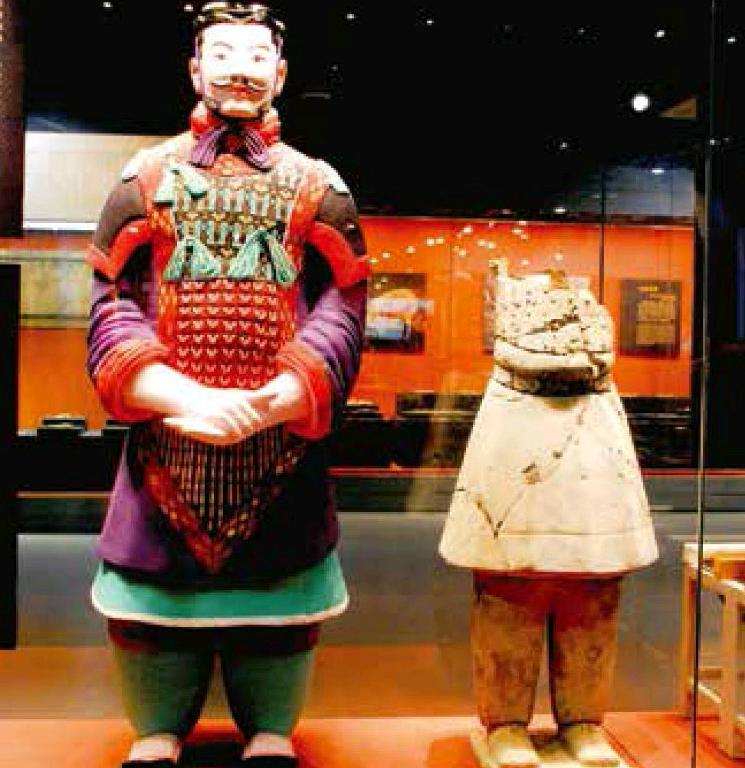丝路文物展重现千年文明
2017-09-07葛宏庚
葛宏庚
丝绸之路绵亘万里,延续千年,积淀了无数文化遗产,这些承载人类文明的宝贵文化遗产为全人类所共有。2014年6月22日,中国、哈萨克斯坦、吉尔吉斯斯坦三国联合申报世界文化遗产“丝绸之路:长安——天山廊道的路网”成功。
3年后的2017年6月22日,“古道新知:丝绸之路文化遗产科技成果展”在杭州的中国丝绸博物馆举办。从公元前5世纪到公元8世纪,从哈萨克斯坦,到我国的新疆、甘肃、陕西,144件精美而珍贵的展品、—段段鲜为人知的历史故事,在时空穿越中重现千年丝路的文明与辉煌

丝路古韵袅千秋
走进展厅,就可以看到一对华丽的车舆立在中间,吸引人们的眼球。在车舆旁边,则是一些玻璃柜,里面摆放着出土的车舆零件、饰件等文物。这些豪车来自甘肃张家川马家塬战国墓地。
马家塬墓地自2006年始共发掘墓葬60余座,发掘整理工作仍在进行中。墓地年代为战国晚期,其规格和等级较高,应是戎人首领及贵族墓地。马家塬墓地以独特的形制、华丽的车舆、豪华的服饰以及一大批珍贵文物而著称,充分体现了战国晚期西戎文化的独特性、多元性。马家塬墓地共有60余座墓葬,绝大多数墓葬中随葬有车辆或车器,其形制之多样,装饰之华丽实为罕见。
车舆是古代机械制造最高工艺水平的集大成者。马家塬墓地出土的大量车舆,为中国古代车舆的研究及复原提供了不可多得的实物资料。考古工作者通過现代科技手段对车辆本体及装饰材料进行科学分析鉴定,再结合传统工艺,总结马家塬战国墓地出土随葬车舆的形制、装饰及制作工艺,实现数字模拟复原及实物复原。在展厅展出的古代豪车并不是原本出土状态的车舆,而是利用资料图与科技手段复原出来的车辆。
此次展出的不少文物都与甘肃敦煌悬泉置遗址有关。悬泉置遗址于1987年首次发现。1990年至1992年进行发掘,出土大量简牍及货币兵器、农具猎具、丝绸服饰、谷物粮食、石砚毛笔等各类遗物。这个遗址出土的文物可以分为汉简和器物两大部分,器物佐证了简牍,简牍复活了器物。涉及日常生活的器物有陶器、木器、漆器、石器、骨器、丝织品、皮鞋等,其中锦、罗、纱、绢等丝绸残片正是丝绸之路名副其实的实物见证。
此次展出的被称为“我国最早的环境保护法”的《月令诏条》,就是在悬泉置遗址发现的。《月令诏条》,是西汉时由王莽奏呈,以太皇太后名义颁布的一份诏书,主要涉及一年四季的农事活动安排与自然生态保护的禁令,上面明确地写着什么时候该收谷,什么时候不能捕鱼……策展人周旸介绍,这件文物出土时已经破碎为200余块,是经过多次拼合修复才大致恢复了原貌,它被认为是迄今为止我国发现最早的一部关于环境保护的法规。
2014年6月22日,悬泉置遗址作为中国、哈萨克斯坦和吉尔吉斯斯坦三国联合申遗的“丝绸之路·长安——天山廊道的路网”遗址点,成功列入《世界遗产名录》。
西域奇珍争亮相
2001年,西安南郊西安理工大学曲江新校区发现一座未经盗掘的唐代小型洞墓。出土遗物有玉器、银器、铜器、瓷器等十余类。根据墓志可知,墓主人是唐高祖李渊第五代孙女李倕——一位真正的大唐公主。她葬于唐开元二十四年(736年),时年只有25岁。
“这位公主的出土遗物非常多,包括玉器、瓷器、银器、铜器等十余类,但主体还是可以分为两类,生前所用之物和后事随葬之物”。策展人周旸说。复原的头冠和生前穿的华美饰物,光一件头冠,就包含了金、银、铜、铁、玛瑙、珍珠、琥珀、绿松石、玻璃等多种材质,工艺之精湛、数量之众多,再现这位大唐公主的奢华生活,映射出盛唐长安的物质文明。
1974年3月11日兵马俑被发现,向世人打开了一个秦始皇营造的地下帝国。它被誉为“二十世纪考古史上伟大的发现之一”和“世界第八大奇迹”,1987年被联合国教科文组织批准列入《世界遗产名录》。
秦俑的陶体表面原本均施有明快艳丽的彩绘,但考古发掘中由于湿度变化造成底层收缩卷曲,导致彩绘层脱落。1999年首次采用“抗皱缩剂和加固剂联合处理法”,对二号坑彩绘跪射俑实施彩绘保护并获得成功。

本次展览除了展出面部表情传神韵的兵马俑头像真迹之外,还有一尊由考古科研人员将色彩还原的真彩秦俑,参观者驻足观赏,赞叹不已。
1995年,考古工作者在新疆尉犁县营盘遗址清理发掘了一个汉晋时代的大型墓地。营盘遗址位于地处丝绸之路楼兰道要冲。营盘墓地中,最引人注目的是15号墓出土的营盘男尸。他被放置在展厅中一个长长的玻璃柜中,引得人们纷纷围观。他戴着贴金面具、身着中西合璧的奇美华服。据专家推测,这具男尸大约生活在1800年前的东汉时期,身高180厘米以上,身份可能是一位来往于丝路从事贸易的年轻富商。
敦煌320窟的形制为方形覆斗顶,是盛唐的代表窟之一。南壁千佛之中有一铺释迦说法图,说法图的上部绘有四身两两相对飞天,线描流畅,色彩艳丽,造型优美,是莫高窟飞天艺术中的杰出作品。这次大展展出的正是敦煌320窟的数字化复原成果。敦煌研究院的王小伟介绍,这是敦煌最美的飞天,“你看她们身上的衣裙飘逸,很有丝绸的质感:据此就能知道当时丝绸之路的深远影响了。”
开放交流写新篇
“古道新知”展分“草原之路——丝路发端”“秦皇汉武——丝路开启”“都城西陲——丝路繁荣”三个板块展示丝绸之路文化遗产。开幕式上,由21家国家文物局重点科研基地联合倡议而成立的“丝绸之路文物科技联盟”举行了签名仪式。开幕式后,作为展览的重大学术配套活动,为期两天的“古道新知:丝绸之路文化遗产保护科技成果”学术报告会解读丝绸之路文化遗产开放与交流、永续发展与繁荣等问题。
联合国教科文组织驻华代表处主任欧敏在开幕式致辞中指出,丝绸之路上流通的陶瓷、纸张、木头、雕塑、金属、漆器、丝绸等,在“古道新知”展览中得以系统展示,为我们带来了跨越时空的科学、艺术信息。同时,她对“丝绸之路文物科技联盟”给予了高度评价。
萨尔马特人是生活在古代欧亚草原上的游牧民族,是曾经的南俄草原霸主。萨尔马特女祭司墓位于哈萨克斯坦,墓葬年代为公元前6世纪至公元前5世纪,出土时发现了大量丰富而复杂的陪葬品,包括装饰服装和身上的金饰、玻璃珠及器皿、贴金木质容器、马具等,尤其是那独特冠饰令人惊奇万分。
在展览现场,伊塞克金人墓出土的尖顶帽,高近70厘米,缀着很多金饰和马、雪豹、山羊、鳥、树等纹饰,熠熠闪光,显示墓主是一位具有显赫社会地位的女祭司,由此折射出哈萨克斯坦的另一种游牧文明。
文化诉说历史,历史凝结文化,文化交流是千年丝路最重要的交流。此次大展昭示着2000多年前先辈开拓的丝绸之路,令“使者相望于道,商旅不绝于途”,打开了各国友好交往的新窗口,书写了人类交流发展的新篇章。
On June 22, 2014, UNESCO designated a 5,000 km stretch of the Silk Road network from Central China to the Zhetsyu Region of Central Asia as a World Heritage Site. This stretch is officially known as Silk Roads: the Routes Network of Changan-Tianshan Corridor, which spans China, Kazakhstan and Kyrgyzstan and includes 33 new sites and several previously designated heritage sites.
In commemoration of the designation in 2014, China Silk Museum in Hangzhou held a silk-centered exhibition with 144 exhibits covering the long corridor stretching from the east to the west. The exhibition goes from June 22 through September 24.
The exhibits highlight a period of about 1,300 years from the 5th century BC to 8th century AD. A big part of the exhibits were unearthed from Chinese sites along the Silk Roads. One of the key archaeological discoveries is Xuanquanzhi Site, Dunhuang, Gansu Province. The site was first spotted in 1987 and the archaeological dig proceeded from 1990 to 1992. Unearthed at the site were a lot of objects that fall into two major categories: bamboo slips bearing documents of the Han Dynasty (202BC-220AD), and everyday life objects including objects made of stone, wood, bone, silk, and leather. Various silk fabrics on display verify the reputation of Silk Roads in the region.
The most noteworthy exhibit from Xuanquanzhi Site is probably Chinas most ancient law on environmental protection issued by the royal house in the Western Han. The decree stipulates dos and donts in farming and environment protection all the year round. The decree was in over 200 pieces when it was unearthed. Experts restored the object after many tries. The site is a part of the Silk Road network designated by UNESCO.
Some exhibits on display came from a tomb unearthed in a southern suburb of Xian, a key city on the Silk Road in ancient times. It was discovered on a college campus under construction. The tomb had never been visited by tomb robbers. It was a tomb of a princess who died at the age of 25 in 736 AD. The objects unearthed from the tomb fall into two categories: the things the princess used in her aborted young life and the burial objects meant for her afterlife in another world. Her headgear, something that resembles a crown, is ornately decorated with gold, silver, pearl, agate, amber, turquoise, glass. The imperial headgear reflects not only the luxury the princess enjoyed but also the material prosperity of the Tang dynasty.
Also on display at the exhibition are some terracotta warriors excavated in Xian, where the mausoleum of the First Emperor of the Qin is situated. The biggest 20th-century archaeological discovery was made in 1974 when a local farmer stumbled onto the underground army while sinking a well. The gigantic site became a UNESCO world heritage site in 1987. The original terracotta warriors had bright colors painted on them. The colors faded and peeled off due to increased moisture in the air during the dig. In 1999, a technique was successfully developed to protect the colors. At the exhibition, there is a real terracotta warrior with the authentic colors restored.
The scariest exhibit at the exhibition is probably a well preserved mummy unearthed at a tomb in Xinjiang in 1995. It came from a cemetery that dates back to the centuries that spanned the Eastern Han (25-220AD). The mummy is dressed in garments in luxurious colors and wears a gold mask. The 1.80-meter-tall young man lived about 1,800 years ago and was very probably a rich businessman who traveled along the Silk Road.
Some exhibits came from Kazakhstan. Specifically, they came from a tomb of a priestess of the Sarmatians, a nomadic tribe that flourished and roamed the Eurasian grasslands from about the 5th century BC to the 4th century AD. The tomb had an abundant quantity of burial objects, testifying to the noble position of the woman living in the 6th or 5th century BC.
At the opening ceremony of the exhibition, 21 key science bases of the National Bureau of Cultural Relics signed an agreement to set up a league of science and technology for cultural relics of the Silk Roads. Experts from the key bases will focus on scientific and technological issues of preserving cultural relics of the Silk Roads and promote academic exchanges.
A representative from UNESCO China Office spoke at the ceremony, confirming the significance of the new perspectives people have of the ancient Silk Roads.
